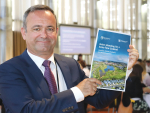Some major milestones for the dairy industry: it now has 5 million cows being milked and last season milk production hit a record 1.89 billion kgMS – up 3.6% on the previous season.
According to DairyNZ senior economist Matthew Newman the increase was due to more cows and the production per cow. NZ now produces 56% more milk than a decade ago.
But Newman warns that the records set out in DairyNZ's and LIC's annual statistics report are likely to be short-lived due to the lower payout this season.
"We also know the numbers will come back from the downturn in milk prices which has seen 240,000 cows culled over the last 12 months. Farmers are concentrating a bit more on their better producing animals and ensuring they are fed well. That means more poor-producing cows will be culled this season."
Newman says the industry's forecast of a 5% drop in milk production this year signals a drop in cow numbers and probably a drop in the use of supplements. Other sources have told Dairy News they believe milk production will be down further.
The 50-page report contains a wealth of interesting data about the expansion of the industry and its trends. Take herd size: just over 50% of herds have 100-349 cows, 29% have 500 or more, 12% 750 cows and 5% 1000 cows or more.
On herd locations: 74% are in the North Island vs 26% in the South Island; but in respective milk volumes the gap is not so pronounced: 60.2% of all milk is produced in the North Island (especially Waikato) and 39.8% in the South Island (mostly North Canterbury followed by Southland).
This is backed up by the statistics on herd sizes in the regions. In Taranaki, for example, the average herd size is 291 cows vs Waikato's average herd size of 335. In the South Island, the North Canterbury herd size is 808 and Southland 590.
The report also highlights the move to Kiwi-cross cows.
"We now have 45% cross-bred cows in the national herd vs about 28% a decade ago. The cross-bred cow is well suited to NZ conditions because they are a bit smaller than Holstein Friesian so there is less damage to wetter soils, They are very efficient at converting feed into milk," says Newman.
The statistics also reaffirm that though Holstein-Friesian cows produce more milk, the beloved Jersey, linked closely to Taranaki, produces the highest percentage of milk solids – 9.87% versus the Holstein-Friesian 8.18% and the Kiwi-cross at 8.92%.
Newman says the report highlights how good and efficient the NZ dairy industry is, its work in producing better cows and feed having paid off.
"NZ dairy cows are very efficient producers of milk because of concentrated genetic gain over a long time and the emphasis on quality feed from pasture. The improved cows are turning that pasture into milk and that's NZ's competitive advantage."
Tale of tape
-
-
- 5 million cows
- 11,970 herds
- 419 (average herd size)
- 146ha (average farm size)
- 67% of herds run by owner operators
- 32.4% of herds run by sharemilkers
- 2.87 cows/ha


















